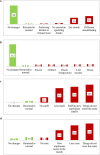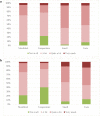Subjective Mouthfeel and Temperature Alterations in COVID-19 Patients Six to Ten Months After Diagnosis
- PMID: 36406042
- PMCID: PMC9660145
- DOI: 10.1007/s12078-022-09304-y
Subjective Mouthfeel and Temperature Alterations in COVID-19 Patients Six to Ten Months After Diagnosis
Abstract
Introduction: The characteristics and impact of mouthfeel, temperature, smell, and taste alterations in patients with COVID-19 at a long term are yet not well known. In this study, these characteristics and their impact on daily life and quality of life (QoL) were assessed, six to ten months after infection, in patients with COVID-19 searching for peer support on Facebook.
Methods: Between December 2020 and January 2021, members of two COVID-19 Facebook groups were invited to complete a questionnaire. Participants were asked to report their perception of mouthfeel, temperature, smell, and taste alterations and their impact.
Results: The questionnaire was completed by 157/216 respondents (73%), with 92% being women. Alterations in mouthfeel, temperature, smell, and taste were reported by respectively 66, 40, 148, and 133 participants. The most frequently reported mouthfeel alterations were "a different feeling" and "dry mouth" in 38 and 30 participants, respectively. Preferences for food temperature were equally changed to "freezing", "cool", "room temperature", "a bit warmer", and "warmer". An impact on daily life and QoL was reported by most patients with alterations in mouthfeel (91% and 79%), temperature (78% and 60%), smell (98% and 93%), and taste (93% and 88%), respectively.
Conclusions: Patients with COVID-19 searching for peer support on Facebook experienced, next to smell and taste alterations, mouthfeel and temperature disturbances, six to ten months after infection. These alterations have an impact on daily life and QoL.
Implications: Health professionals should, next to smell and taste alterations, be aware of mouthfeel and temperature alterations in patients with COVID-19.
Supplementary information: The online version contains supplementary material available at 10.1007/s12078-022-09304-y.
Keywords: COVID-19; Long COVID; Mouthfeel; Quality of life; Smell; Taste.
© The Author(s) 2022.
Conflict of interest statement
Conflict of InterestThe authors declare no competing interests.
Figures





Similar articles
-
Taste, smell and mouthfeel disturbances in patients with gastrointestinal stromal tumors treated with tyrosine-kinase inhibitors.Support Care Cancer. 2022 Mar;30(3):2307-2315. doi: 10.1007/s00520-021-06658-z. Epub 2021 Nov 2. Support Care Cancer. 2022. PMID: 34727226
-
Altered smell and taste: Anosmia, parosmia and the impact of long Covid-19.PLoS One. 2021 Sep 24;16(9):e0256998. doi: 10.1371/journal.pone.0256998. eCollection 2021. PLoS One. 2021. PMID: 34559820 Free PMC article.
-
Taste and smell disturbances in patients with chronic oral graft vs. host disease: An observational study.Front Oral Health. 2022 Sep 9;3:934607. doi: 10.3389/froh.2022.934607. eCollection 2022. Front Oral Health. 2022. PMID: 36160117 Free PMC article.
-
Smell and taste alterations in COVID-19 patients: a systematic review.Rev Assoc Med Bras (1992). 2020 Nov;66(11):1602-1608. doi: 10.1590/1806-9282.66.11.1602. Rev Assoc Med Bras (1992). 2020. PMID: 33295417
-
Soft materials deformation, flow, and lubrication between compliant substrates: impact on flow behavior, mouthfeel, stability, and flavor.Annu Rev Food Sci Technol. 2014;5:373-93. doi: 10.1146/annurev-food-030212-182657. Epub 2014 Jan 2. Annu Rev Food Sci Technol. 2014. PMID: 24387605 Review.
Cited by
-
A Simple Taste Test for Clinical Assessment of Taste and Oral Somatosensory Function-The "Seven-iTT".Life (Basel). 2022 Dec 25;13(1):59. doi: 10.3390/life13010059. Life (Basel). 2022. PMID: 36676008 Free PMC article.
-
Oral Manifestations in the Post COVID-19 Condition: A Systematic Review With Meta-Analysis.Rev Med Virol. 2025 Jul;35(4):e70057. doi: 10.1002/rmv.70057. Rev Med Virol. 2025. PMID: 40663038 Free PMC article. Review.
References
-
- Boscolo-Rizzo P, Tirelli G, Meloni P, Hopkins C, Madeddu G, De Vito A, Gardenal N, Valentinotti R, Tofanelli M, Borsetto D, Lechien JR, Polesel J, De Riu G, Vaira LA (2022) Coronavirus disease 2019 (COVID-19)-related smell and taste impairment with widespread diffusion of severe acute respiratory syndrome-coronavirus-2 (SARS-CoV-2) Omicron variant. Int Forum Allergy Rhinol 12:1273–1281. 10.1002/alr.22995 - PMC - PubMed
LinkOut - more resources
Full Text Sources
